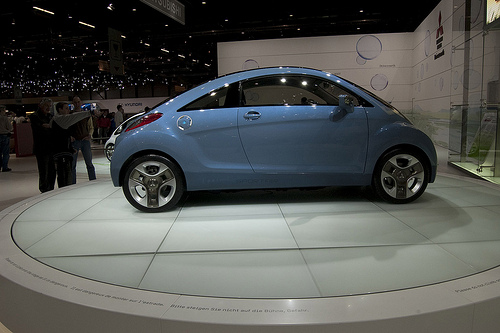In today’s global competitive environment, automobile manufacturers need to be socially responsible and adopt eco-friendly practices in order to lower cost and improve profitability. To reduce dependence on fossil fuels and minimize air pollution, some automobile manufacturers are switching to renewable energy and designing vehicles to run on solar energy. These solar panels work in a similar way to solar panels on your house; the solar panels mounted on the car roof harness energy from the sun to generate electricity and power up the car’s motor. Solar powered cars will appeal to those who are more environmentally conscious. In fact, the first solar powered car was developed 58 years ago! Here is a bit of information about solar powered cars, both then and now.
The first solar car
The first solar powered car, called the Sunmobile, was invented in 1955 by William G. Cobb of General Motors. This 15-inch solar car was made up of 12 selenium photovoltaic cells. When sunlight hits the 12 photovoltaic cells, a small Pooley electric motor will move a pulley which in turn rotated the real wheel shaft. However, the Sunmobile was too small to drive.
More recent solar powered automobiles
The i-MiEV (Mitsubishi innovative Electric Vehicle) sport is a battery powered 2+2 coupe car that is partially charged via the solar panels mounted on its roof and can be charged 80 percent in just 20 minutes. The vehicle has a top speed of 87 mph and is ideal for urban areas.
The first mass produced all-electric car in China is BYD Auto’s E6 electric car. The 5-seat car is equipped with BYD-developed iron-phosphate “Fe” battery, with an expected range of 186.4 miles on a single charge on urban roads. Its projected top speed is 87 mph, making it an ideal choice for daily commuting, city driving and long distance travel.
Toyota’s Prius 2013 is a fuel efficient car that returns an EPA estimated 50 mpg combined city and highway driving. The solar panels embedded on the roof are used to power a fan and circulate air through the cabin. The remote air conditioning system allows you to cool the cabin before you enter the car. This vehicle achieved a strong safety record. It was awarded the National Highway Traffic Safety Administration (NHTSA) 5-Star Overall Safety Rating in the United States. In addition, it was certificated as an Advanced Technology Partial Zero Emission Vehicle (AT-PZEV) in California.
The future of solar power and automobiles
With continued research and innovations, we will see more breakthroughs in solar powered cars. In an effort to strike a balance between profitability and preserving our limited natural resources, collaborations have been formed between some automobile manufacturers and other multinational companies to grow business through technology innovations. For example, a recent collaboration between Honda’s U.S. Division and SolarCity might result in Fit EV and Accord Plug-In Hybrid owners being able to charge their cars from the power of the sun in the future. The $65 million deal, which was signed in February 2013, includes installing discounted solar panels on the rooftop of your home for Honda and Acura customers in the United States. Hence, if you are a Honda or Acura customer, you will be able to install solar panels for your home with little or no upfront cost.
As car manufacturers are facing intense global competition and the pressing need to be environmentally friendly, researchers are incorporating sustainable technologies in their vehicle designs in order to improve safety performance and maximise performance while keeping costs low. As we reduce our reliance on fossil fuels, solar powered cars will gain popularity among cost-conscious and environmentally-conscious consumers.

